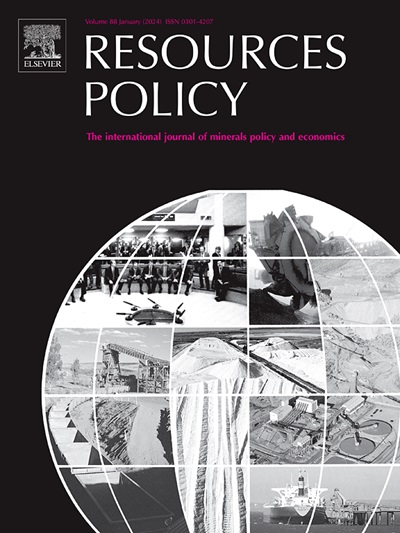Advancing digital transformation in the mining industry: A novel rough interval-valued neutrosophic DEMATEL approach to challenge interdependencies
IF 10.2
2区 经济学
0 ENVIRONMENTAL STUDIES
引用次数: 0
Abstract
The mining industry (MI) underpins global economic and technological progress by supplying essential raw materials for energy, manufacturing, and infrastructure. Yet, its digital transformation, vital for enhancing sustainability and efficiency, is hindered by complex, interconnected challenges. Prior research often examines these challenges in isolation, lacking quantitative causal modeling. This study proposes the Rough Interval-Valued Neutrosophic Decision-Making Trial and Evaluation Laboratory (RIVN-DEMATEL) method to analyze interdependencies among challenges to digital technology adoption in the MI. Integrating rough set theory and neutrosophic logic, RIVN-DEMATEL robustly manages uncertainty in expert judgments, validated via Spearman and Pearson correlation analyses. Key findings identify scalability challenges, cultural inertia, and dynamic operational conditions as dominant causal drivers, which exacerbate effect factors such as resistance to change, cybersecurity risks, and ROI uncertainty. Scalability constraints, for instance, amplify integration issues and data complexity, while cultural barriers fuel workforce resistance. These results underscore the need to address root causes to mitigate downstream impacts. Practical implications include launching modular pilot projects to demonstrate scalability, fostering cultural change through transformational leadership, and implementing reskilling programs to build digital literacy. Moreover, policymakers should establish adaptive regulatory frameworks and offer financial incentives, such as grants for small and medium-sized enterprises (SMEs), to reduce adoption challenges. By synthesizing fragmented insights into a structured decision-support model, this study fills critical literature gaps, providing mining companies, policymakers, and technology providers a roadmap to advance operational efficiency, environmental sustainability, and social responsibility through digital innovation.
推进采矿业的数字化转型:一种新的粗糙区间值中性DEMATEL方法来挑战相互依赖性
采矿业通过为能源、制造业和基础设施提供必要的原材料,支撑着全球经济和技术进步。然而,对提高可持续性和效率至关重要的数字化转型却受到复杂且相互关联的挑战的阻碍。先前的研究往往孤立地考察这些挑战,缺乏定量的因果模型。本研究提出了粗糙区间值中性决策试验和评估实验室(RIVN-DEMATEL)方法来分析MI中数字技术采用挑战之间的相互依赖性。RIVN-DEMATEL结合粗糙集理论和中性逻辑,稳健地管理专家判断中的不确定性,并通过Spearman和Pearson相关分析进行了验证。主要研究发现,可扩展性挑战、文化惯性和动态操作条件是主要的因果驱动因素,这些因素加剧了诸如抵制变革、网络安全风险和投资回报率不确定性等影响因素。例如,可伸缩性限制放大了集成问题和数据复杂性,而文化障碍助长了劳动力的阻力。这些结果强调了解决根本原因以减轻下游影响的必要性。实际影响包括启动模块化试点项目以展示可扩展性,通过变革型领导促进文化变革,以及实施再培训计划以建立数字素养。此外,决策者应该建立适应性监管框架,并提供财政激励,例如为中小企业提供赠款,以减少采用挑战。通过将碎片化的见解整合到结构化的决策支持模型中,本研究填补了关键的文献空白,为矿业公司、政策制定者和技术提供商提供了通过数字创新提高运营效率、环境可持续性和社会责任的路线图。
本文章由计算机程序翻译,如有差异,请以英文原文为准。
求助全文
约1分钟内获得全文
求助全文
来源期刊

Resources Policy
ENVIRONMENTAL STUDIES-
CiteScore
13.40
自引率
23.50%
发文量
602
审稿时长
69 days
期刊介绍:
Resources Policy is an international journal focused on the economics and policy aspects of mineral and fossil fuel extraction, production, and utilization. It targets individuals in academia, government, and industry. The journal seeks original research submissions analyzing public policy, economics, social science, geography, and finance in the fields of mining, non-fuel minerals, energy minerals, fossil fuels, and metals. Mineral economics topics covered include mineral market analysis, price analysis, project evaluation, mining and sustainable development, mineral resource rents, resource curse, mineral wealth and corruption, mineral taxation and regulation, strategic minerals and their supply, and the impact of mineral development on local communities and indigenous populations. The journal specifically excludes papers with agriculture, forestry, or fisheries as their primary focus.
 求助内容:
求助内容: 应助结果提醒方式:
应助结果提醒方式:


